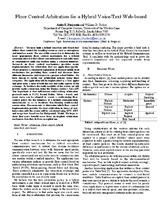| dc.contributor.author | Benjamin, Anita | |
| dc.contributor.author | Tucker, William David | |
| dc.date.accessioned | 2013-02-18T19:27:33Z | |
| dc.date.available | 2013-02-18T19:27:33Z | |
| dc.date.issued | 2003 | |
| dc.identifier.citation | Benjamin, A. & Tucker, W. D. (2003). Floor control arbitration for a hybrid voice/text web-board. In Z. Miklos (ed.), Southern African Telecommunications Networks & Applications Conference (SATNAC), 2: 301–302, George, South Africa | en_US |
| dc.identifier.isbn | 0-620-30948-2 | |
| dc.identifier.uri | http://hdl.handle.net/10566/538 | |
| dc.description.abstract | We have built a hybrid voice/text web–board that utilizes floor control for handling resources such as microphone and interface events. The aim of this research is to determine the most appropriate floor control mechanism for a hybrid communication tool that allows conventional text and audio users to communicate with one another using a common interface. Research on floor control mechanisms provides many implementations for arbitration that are application-specific. Myers proposes a categorical explanation of the most widely used mechanisms for providing floor control and discusses these different dimensions with respect to a project called Pebbles. We have chosen to model our arbitration policies along these categories. The application will be implemented as a Java applet and gives users a view of both the text and audio aspects of the exchange. To facilitate the multi-modality of the system we will provide media conversion, using the Nuance system’s Java API. Our hypothesis is that well–known multi-tasking arbitration protocols such as FCFS, Round Robin, Token – based, and many more can be adapted to create a conferencing floor control policy for the interface of a hybrid communication environment so as to facilitate free–flowing multi-modal conversation. Measurements to determine which floor control implementation provides the best arbitration in terms of user interaction with the system will be calculated using RPT, ORT and usage tests based on the Kirkpatrick Model. We hope to show that users benefit more from an implicit arbitration mechanism than they do from an explicit one. | en_US |
| dc.description.sponsorship | Telkom, Cisco, THRIP | en_US |
| dc.language.iso | en | en_US |
| dc.publisher | Telkom | en_US |
| dc.rights | Copyright Telkom. This file may be freely used for educational purposes, as long as it is not altered in any way. Acknowledgement of the authors and the source is required | |
| dc.subject | Arbitration | en_US |
| dc.subject | Floor control | en_US |
| dc.subject | Hybrid voice/text | en_US |
| dc.subject | Web-board | en_US |
| dc.title | Floor control arbitration for a hybrid voice/text web-board | en_US |
| dc.type | Conference Proceedings | en_US |
| dc.privacy.showsubmitter | FALSE | |
| dc.status.ispeerreviewed | TRUE | |

